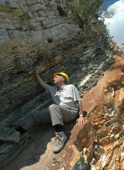Elements, isotopes and organic matter in chemostratigraphy: applications, limitations and implications for global environmental change
4-day short course, with accompanying field excursion, to be taught by Hugh Jenkyns (Oxford)
at the University of Ferrara, Italy, 11th–14th, July, 2011
Course Instructor: HUGH JENKYNS 
Hugh Jenkyns has worked for many years on the palaeoceanography and palaeoclimatology of Mesozoic sediments and has undertaken field work throughout the Alpine-mediterranean region, as well as participating in 3 deep-sea drilling legs in the Pacific Ocean. His research methodology primarily involves the application of isotope ratios (carbon, oxygen, nitrogen, sulphur, iron and other transition metals) to palaeoenvironmental problems. He co-authored the first paper on Oceanic Anoxic Events. He was until recently co-editor of Geology, and lectures at Oxford University.
Background to the course
The use of isotopes in stratigraphy, palaeoclimatology and palaeoceanography has increased enormously over the last few decades. Early studies concentrated on the significance of oxygen-isotope ratios in macrofossils and microfossils but since the early nineteen-eighties the use of carbon-isotope ratios, both as a monitor of change in the global carbon cycle as well as a tool for stratigraphic correlation, has become increasingly important. Strontium-isotope ratios similarly offer an aid to global correlation in the marine realm as well as indicating the relative importance of hydothermal fluxes versus continental weathering as inputs to the oceans. Isotope systems that respond to changes in the redox state of the oceans, such as sulphur and nitrogen, are also under continued investigation, as are the relationships between the carbon and sulphur cycles. With the advent of the latest generation of mass spectrometers, transition-metal isotopes (e.g. Fe, Os, Cr, Mo) and rare-earth metals such as neodymium are beginning to be exploited in palaeoceanography. Early studies of calcium isotopes are also promising as a proxy for continental weathering. Increasingly, the stratigraphical distribution of redox-sensitive elements such as cerium, manganese and iodine is proving valuable for understanding conditions in the ancient water masses.

The course will deal with the significance of a number of sedimentary parameters
• manganese and iodine in carbonates
• organic carbon in sediments
• carbon isotopes (in both marine and terrestrial organic matter; in shallow-water and pelagic carbonates)
• oxygen isotopes in carbonates
• strontium isotopes in carbonates and fossils
• nitrogen isotopes in organic matter
• sulphur isotopes in fossils and carbonates
• neodymium isotopes in fish teeth
• new isotope systems (calcium, iron, molybdenum, chromium, osmium)
• discussion of case histories from the sedimentary record
Most examples will be taken from the Mesozoic sedimentary record.
The field excursion on the 14th July will examine the sedimentary expression of Jurassic (Toarcian) and Cretaceous (early Aptian and Cenomanian–Turonian) Oceanic Anoxic Events in the Southern Alps.
The course will take place at Dipartimento di Scienze della Terra, Università di Ferrara, Via Saragat 1, 44100, Ferrara, Italy. The City of Ferrara lies ~50 km to the north of Bologna in Emilia–Romagna. The city has wide streets and numerous ‘palazzi’ built in the 14th and 15th century. Much of the city is pedestrianized and bicycles are ubiquitous. Sometimes referred to as ‘Italy’s best-kept secret‘ the city has been rated as a World Heritage Site by UNESCO on account of its architectural elegance and cultural significance. The University of Ferrara was founded in 1391.
Language: The course will be taught in English.
Documentation
Those participants requiring documentary evidence that they have attended the course will receive a certificate signed by Hugh Jenkyns.
Costs of attendance
Students: 200 €
Post-doctoral workers and equivalents: 300 €
University staff and equivalents: 450 €
Professionals (oil companies, etc): 700 €
The cost of registration includes:
Course materials, lunches , excursion to Belluno Basin: bus transport and packed lunch
Travel:
Ferrara can be reached by road and rail. Numerous trains run between Ferrara and Bologna, taking between 30 and 50 minutes; Bologna has an international airport with connections to many European cities.
Accomodation:
Hotel, Pension, B&B
Number of participants
Minimum number of course participants: 25
Maximum number of course participants: 35
Those interested in reserving a place on the course are asked to complete the pre-registration form attached below and send it to the organizers before March 30th, 2011. Methods of payment, travel details and information on lodging will be communicated to those that have submitted the pre-registration form.
CLICK TO DOWNLOAD THE PRE-REGISTRATION FORM
Contacts and information on the Course
Prof. Daniele Masetti: msd@unife.it
Dott. Roberta Romano: robroman@unina.it
Dott. Guido Roghi: guido.roghi@igg.cnr.it
Dott. Jacopo Dal Corso: jacopo.dalcorso@unipd.it
2008 Course, University of Trieste

